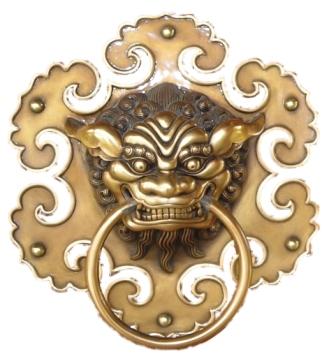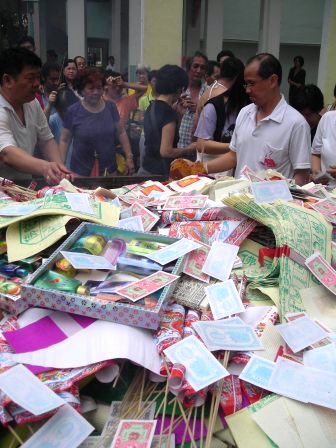 Heng Kang Tian Heng Kang Tian
玄江殿
 In 1953, a group of Hokkien lightermen (workers who work on small boats known to Chinese as Twakoh) founded a shrine (temple or prayer house) in honor of Xuantian Shang Di, 玄天上帝, the Supreme deity of the North. In 1953, a group of Hokkien lightermen (workers who work on small boats known to Chinese as Twakoh) founded a shrine (temple or prayer house) in honor of Xuantian Shang Di, 玄天上帝, the Supreme deity of the North.
The prayer house was located in Amoy Street in Singapore Chinatown, not far away from Thian Hock Keng, where most of the Hokkien migrants lived. The lightermen prayed for peace and for the deity’s blessing for a safe working environment.
In 1970, Mr. Chen Shui Quan (陈水泉), Mr. Zhong Yi Xian(钟义贤) and Mdm Yang You Hao (杨有好) formed a branch temple and named it Heng Kang Tian, 玄江殿. In 1999, this was registered as a Taoist Religious organization.
Heng Kang Tian as a religious institute addresses the religious needs of devotees who pray for blessings, smooth business operations, good health, world peace or blissful family.
Heng Kang Tian and society
A Chinese temple is not just a religious place but also a common social space celebrating festivals as well as social and charity events.
Heng Kang Tian has organized fund raising events to support National Kidney Foundation, organized dinners for senior citizens and handicapped and presenting them with red packets and necessities as well as visits to seniors homes.
In the course of participating in ceremonies and volunteering for activities, devotees at Heng Kang Tian develop strong social bonds with each other. This explains the strong cohesiveness despite several relocations of the temple since its first location.
In a typical temple event, there are the more senior devotees who are usually Mandarin or dialect speaking as well as the younger generation who are English educated and maybe because of their frequent association with their elders and their activities, these English educated younger generations are equally fluent in Mandarin and dialects.
Heng Kang Tian as a heritage site
A recent development in Singapore is also evident in the participants in Heng Kang Dian activities. Many English educated individuals have begun searching for their own cultural roots despite the disadvantage losing the ability to read and sometimes speak Mandarin or dialects. They visit Heng Kang Dian to watch or participate in their activities and through this process becomes in touch with their cultural heritage in their own ways.
Heng Kang Dian has also attracted anthropologists to do their fieldwork, psychologists who want to understand the impact of faith on well being as well as educationalists who research on the relationship between language and cultural practice. These activities are made possible because of the inclusive and welcoming attitude of Heng Kang Tian’s management committee.
Heng Kang Tian’s activities are often colorful and tradition because of lion dance, dragon dance, green lion, Chinese opera and also traditional puppet shows. These activities in turn support a wide range of traditional arts and contribute towards their survival in modern society.
These activities also attracted many expatriates to attend events armed with their cameras and video recorders in their attempts to understand and relate to the cultural fabric of Singapore.
Heng Kang Tian’s history shows how a traditional Chinese institution response to changing currents in the society, continue to serve their devotees and take on new functions that emerges as society evolves. This is made possible by a management committee who welcomes changes and who embraces new ideas.
Heng Kang Tian's history is the subject of documentary "Social History of a Spirit Medium"
Are you a member of Heng Kang Tian or have you visited or participated in their activitities? If yes, share with us your thoughts and experiences.
Heng Kang Tian
玄江殿
85A Silat Road, Singapore 168851
|
Related Articles:

|

 Taoism Main page
Taoism Main page
 Singapore Chinese Temples
Singapore Chinese Temples





 Heng Kang Tian
Heng Kang Tian In 1953, a group of Hokkien lightermen (workers who work on small boats known to Chinese as Twakoh) founded a shrine (temple or prayer house) in honor of Xuantian Shang Di, 玄天上帝, the Supreme deity of the North.
In 1953, a group of Hokkien lightermen (workers who work on small boats known to Chinese as Twakoh) founded a shrine (temple or prayer house) in honor of Xuantian Shang Di, 玄天上帝, the Supreme deity of the North. 